ShopHunter Alternatives: Best Tools for Product Research
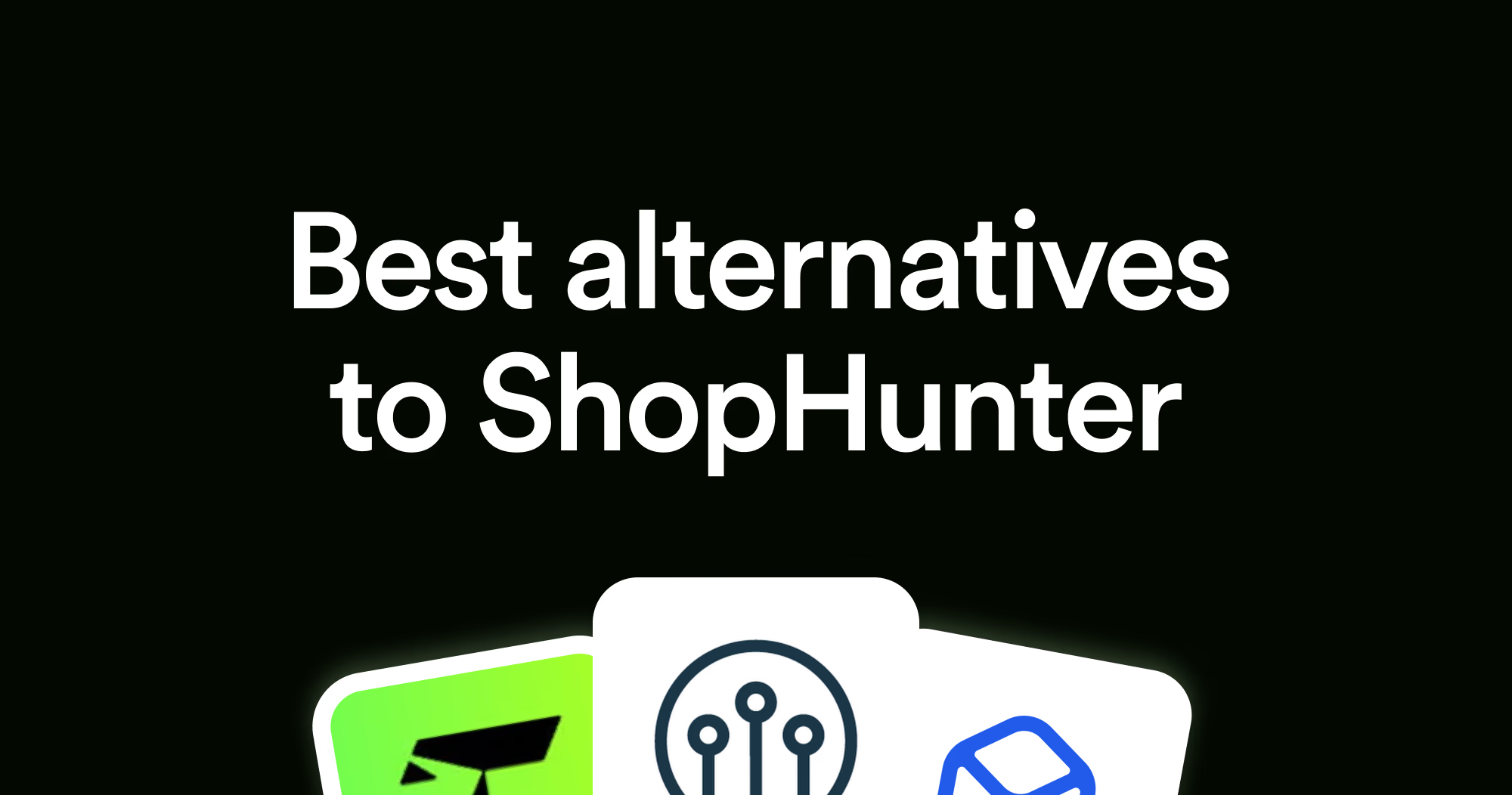
Most dropshippers blindly test products hoping for a winner. However, the top 1% leverage product research tools to validate demand before spending a dollar. ShopHunter has dominated this space, but savvy sellers are discovering its limitations.
Shopify-only analytics, basic ad insights, and increasingly recycled product recommendations that everyone sees. The true competitive edge now comes from diversified intelligence platforms. These platforms reveal what's working across multiple channels before products reach mass saturation.
ShopHunter Alternatives: Best Tools for Product Research
You buy ShopHunter Pro for $75, expecting to find a winning product for your dropshipping store. Weeks later, you still see the same product ideas everyone else is selling. Your Facebook ads flop despite following ShopHunter’s advice exactly.
ShopHunter is popular, but when everyone uses the same tool, opportunities disappear quickly. Success in 2025 requires smarter tools and a unique strategy.
Cost-Effective Solutions for Scaling Dropshippers
You might think multiple tools cost too much, but missing a hit product or being lost in a sea of copycats costs more.
Many free Chrome extensions and freemium tools cover most of what ShopHunter offers. For example, a $27K/month store owner can use only free resources, getting creative with them.
Invest in tools that address specific needs, like finding new ad creatives or trustworthy suppliers. This approach offers better value than a generic, all-in-one platform.
Start with free tools, add paid options for targeted problems as you grow, and replace anything that doesn’t perform. This lets your research toolkit evolve from $0 to $10K+ monthly, fine-tuning your insights and strategies.
Next, we’ll explore the best free, paid, and advanced alternatives to help you build a research stack that fits your goals. Validate product ideas confidently, launch successfully, and learn strategies from the biggest DTC brands in 2025. Stop wasting time scrolling—get the edge you need.
Top ShopHunter Alternatives for Different Use Cases
Product research drives dropshipping success. It separates wins from wasted effort. We identified top ShopHunter alternatives, each excelling in specific scenarios. These tools offer tailored features designed to enhance your ecommerce strategy.
1. Trendtrack – The Comprehensive Competitive Intelligence Alternative
If traditional product research feels like searching for a needle in a haystack, Trendtrack acts like a metal detector. It finds the needle, reveals its composition, identifies who else is targeting it, and shows where to look next.
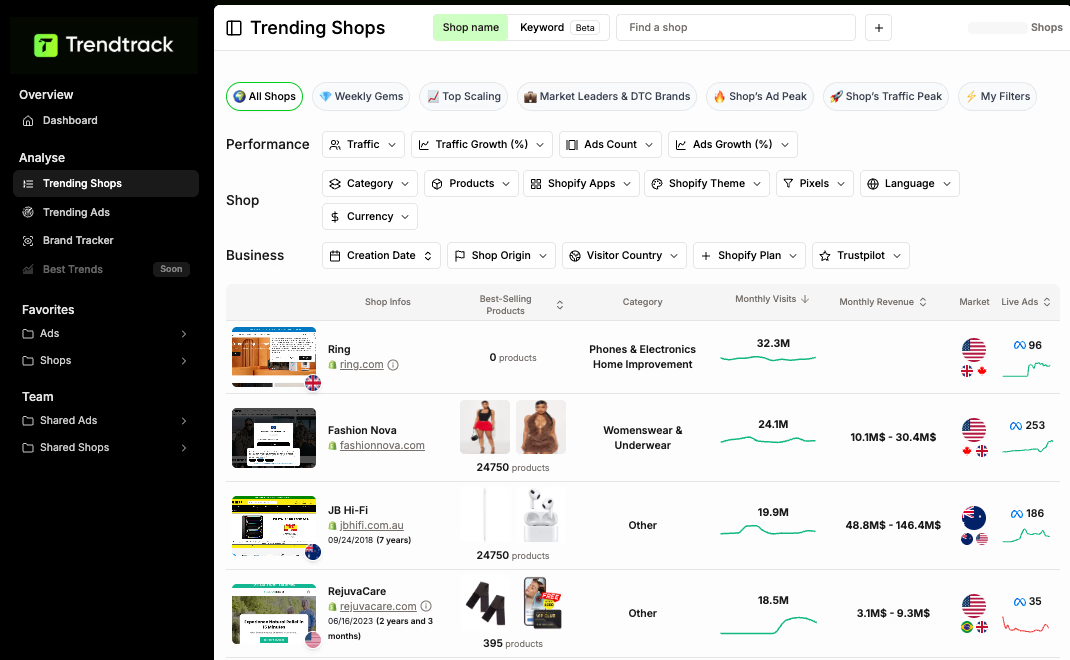
ShopHunter provides the basics for store monitoring. However, Trendtrack transforms competitive intelligence in ecommerce by combining all crucial data. Stores, ads, and market trends. This delivers a complete, up-to-date view of what’s working and why.
Advanced Ad Spy Capabilities and Store Analytics Beyond ShopHunter
ShopHunter reveals what’s in a competitor’s store. Trendtrack explains why those products sell. This is the main difference.
Trendtrack’s detailed ad analysis offers:
- Ad performance metrics: No guesswork. Trendtrack eliminates guesswork by providing clear visibility into ad reach, engagement, and growth over time. This ensures that product–market fit can be validated with data before committing further investment.

- Creative intelligence: Looking for campaign ideas? Filter ads by emotional appeal, problem-solving themes, or user-generated content. This uncovers winning patterns beyond what a product-only tool like ShopHunter delivers.
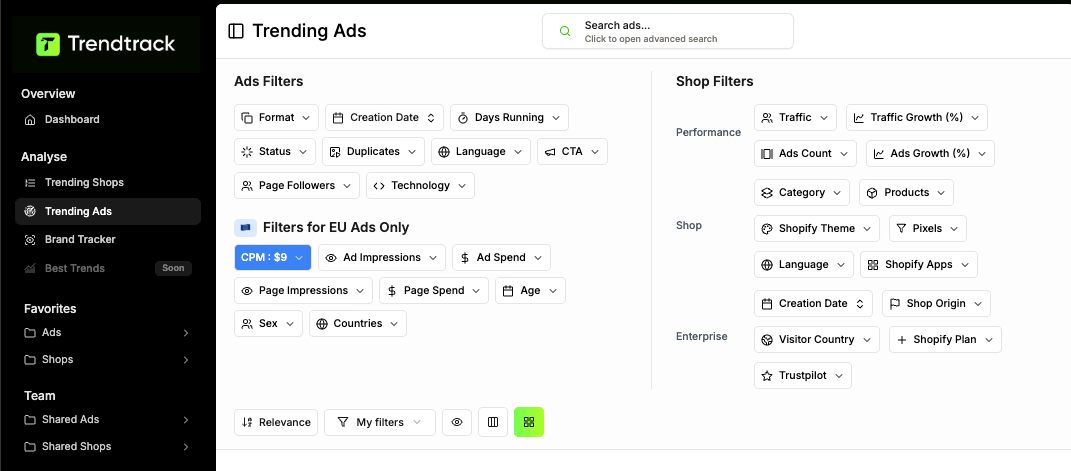
- Spend analysis: Trendtrack shows which creatives perform best, helping brands shift budget to top assets and replicate results.
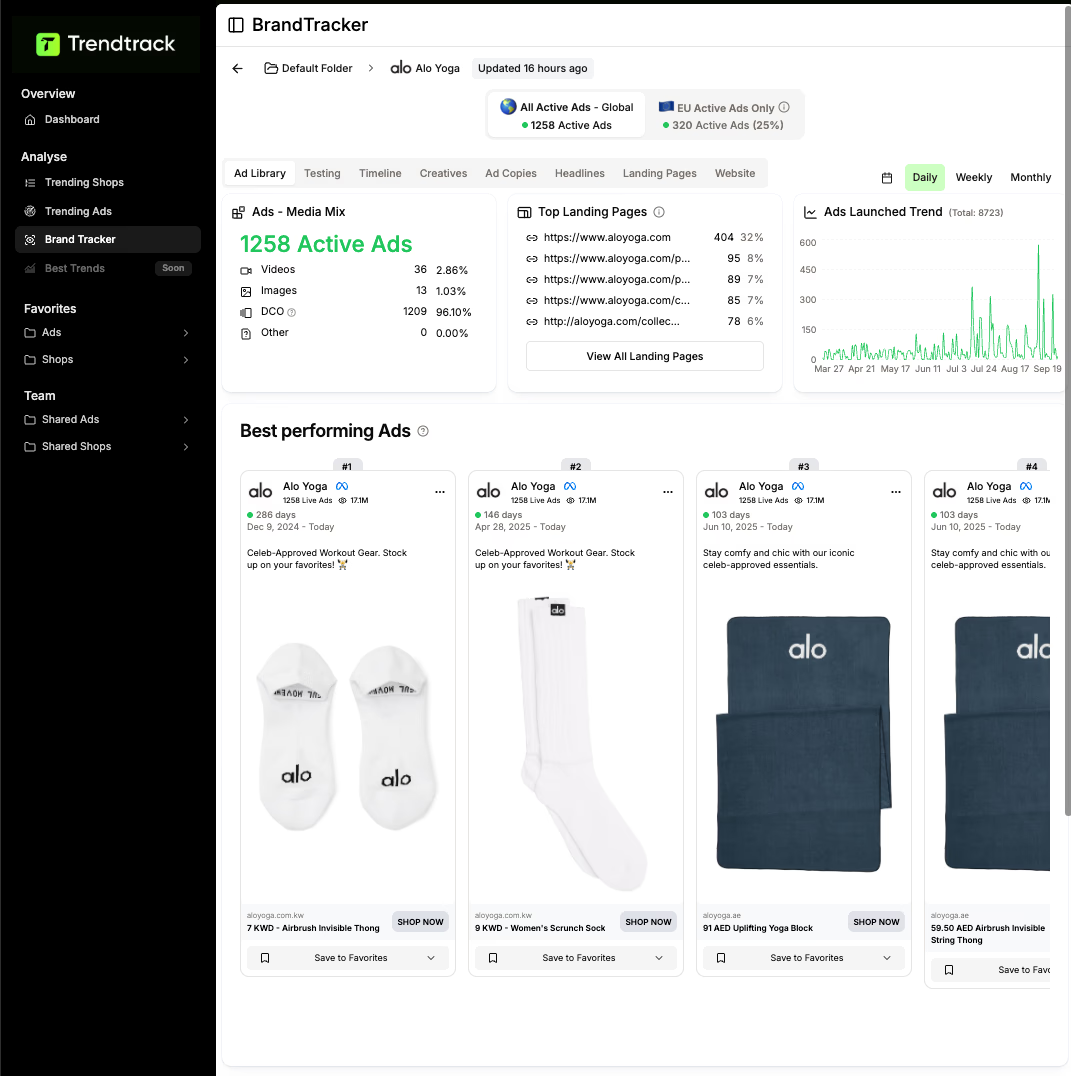
Multi-Platform Support and Deeper Market Insights
ShopHunter focuses on Shopify. Trendtrack tracks multiple ecommerce platforms to give a broader competitive view.
Because shoppers move across platforms, Trendtrack monitors:
- Facebook and Instagram ad intelligence
- Social media trend analysis
- Analyze Shopify store analytics
- Cross-platform ad performance tracking
- Search trend insights
This lets you connect the dots when a new product gains traction simultaneously on TikTok, Facebook ads, and Shopify stores. Allows you to spot the next big trend first.
Find Trending Products Before They Pop
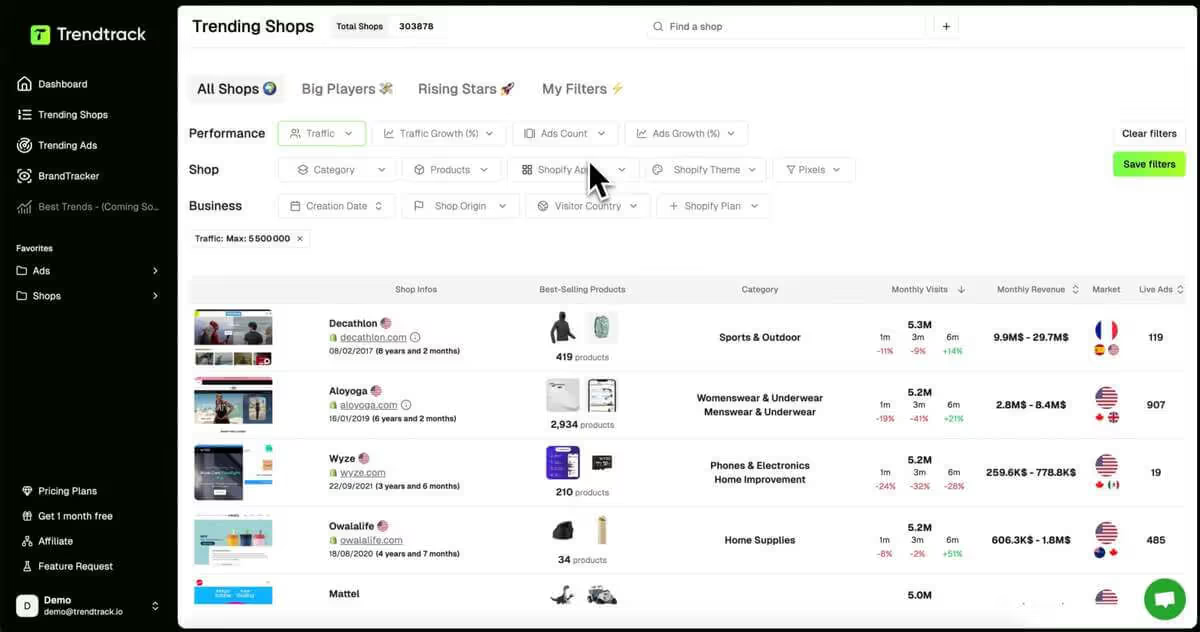
2. Dropship.io
Dropship.io transforms vast data into meaningful insights. It analyzes products daily. Reveals supply chain volatility, competitor saturation, and profit margins. Even accounting for seasonal changes. It provides detailed market context.
The dashboard resembles a professional trader’s toolkit, which may challenge beginners. Yet, its “Demand Velocity” feature helped dropshippers spot trends.
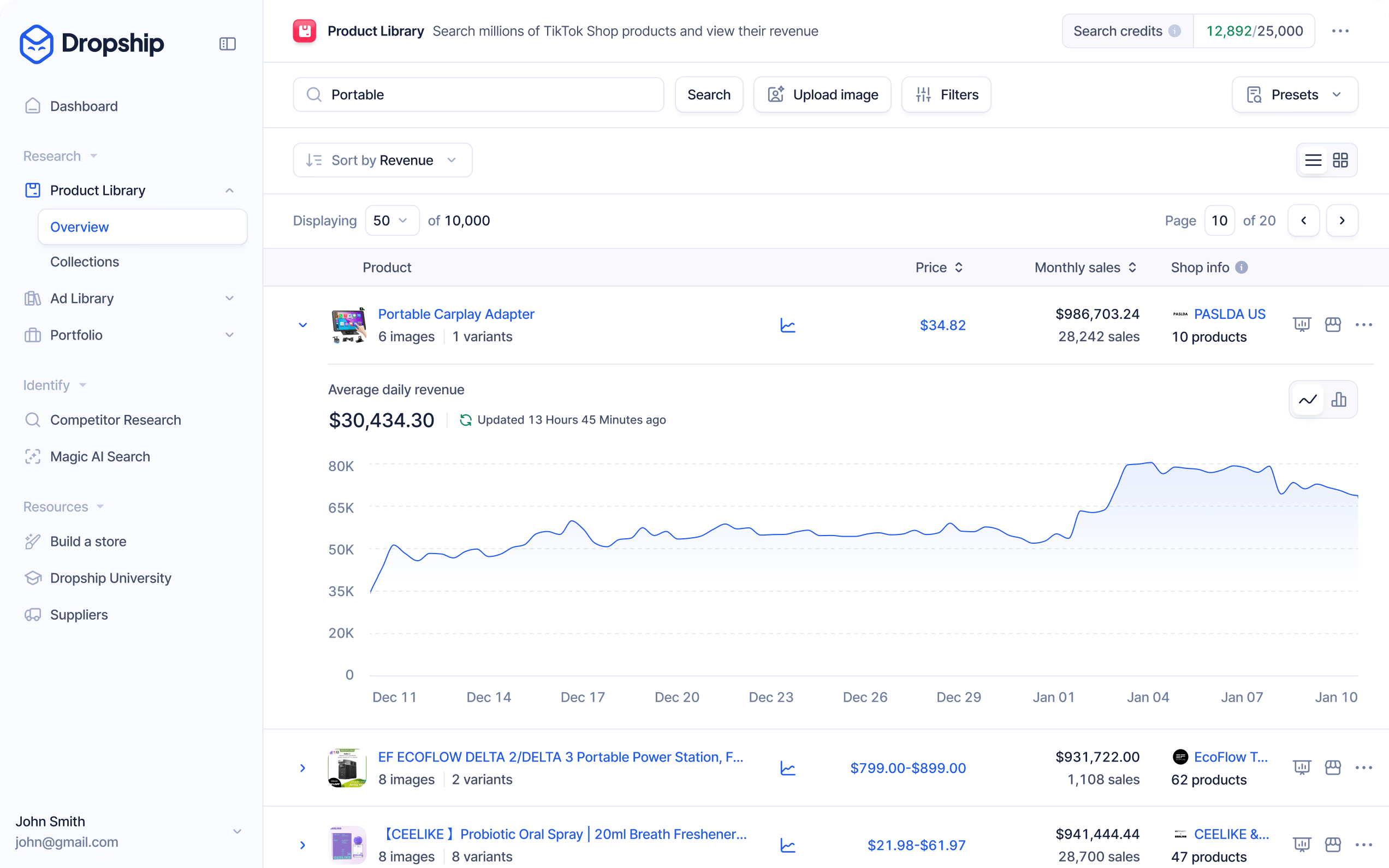
Pricing starts at $39/month. But a single winning product can cover the cost many times over. This tool suits those serious about scaling.
Dropship.io integrates with Shopify, WooCommerce, and BigCommerce. You can push products directly to your store and sync with Facebook Business Manager for precise audience targeting. This surpasses ShopHunter’s ecosystem.
For more options, explore our guide on Dropship.io alternatives.
3. PPSPY
Designed by a former Printful designer, PPSPY targets print-on-demand (POD) sellers where other tools fall short. It tracks design trends and seasonal spikes specifically for POD, helping users identify hot ideas early.
Its visual search lets you upload any design and find similar winners on 17 platforms, including Etsy and Redbubble. In tests, it uncovered profitable designs missed by ShopHunter.
PPSPY includes a community of over 14,000 POD sellers sharing tips and strategies in an integrated forum. This adds valuable peer support.
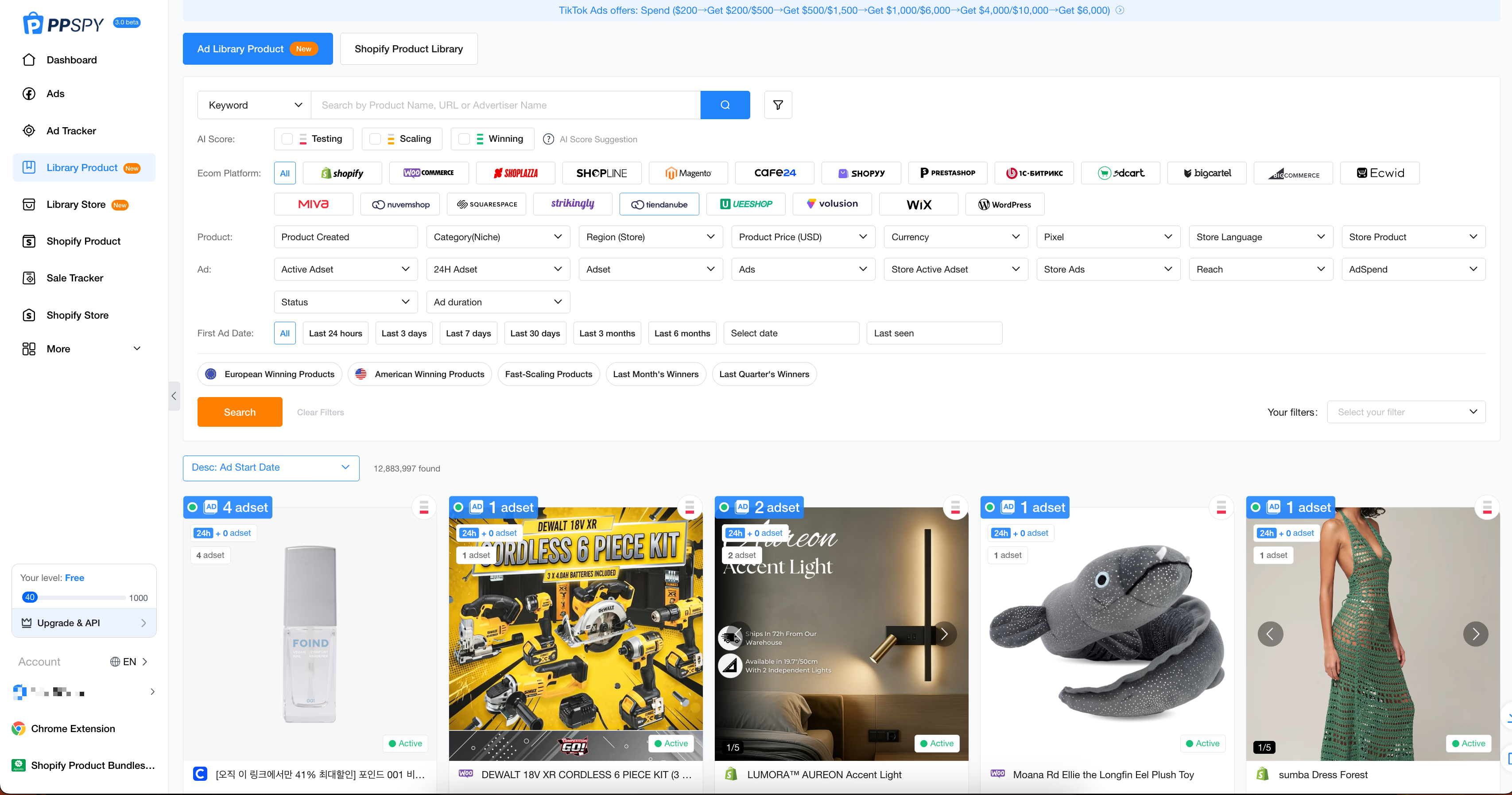
You can customize dashboards by niche or style. With that, you can receive instant alerts for metrics like “designs selling 200+ in 48 hours” or “products with markups over 70%.”
4. Koala Inspector
With a single click on any Shopify store, you can see nearly everything. It reveals revenue estimates, traffic sources, app usage, and theme details without leaving the page. It offers behind-the-scenes access to competitors’ stores.
This browser extension runs great without switching tabs, delivering real-time insights you can apply immediately.
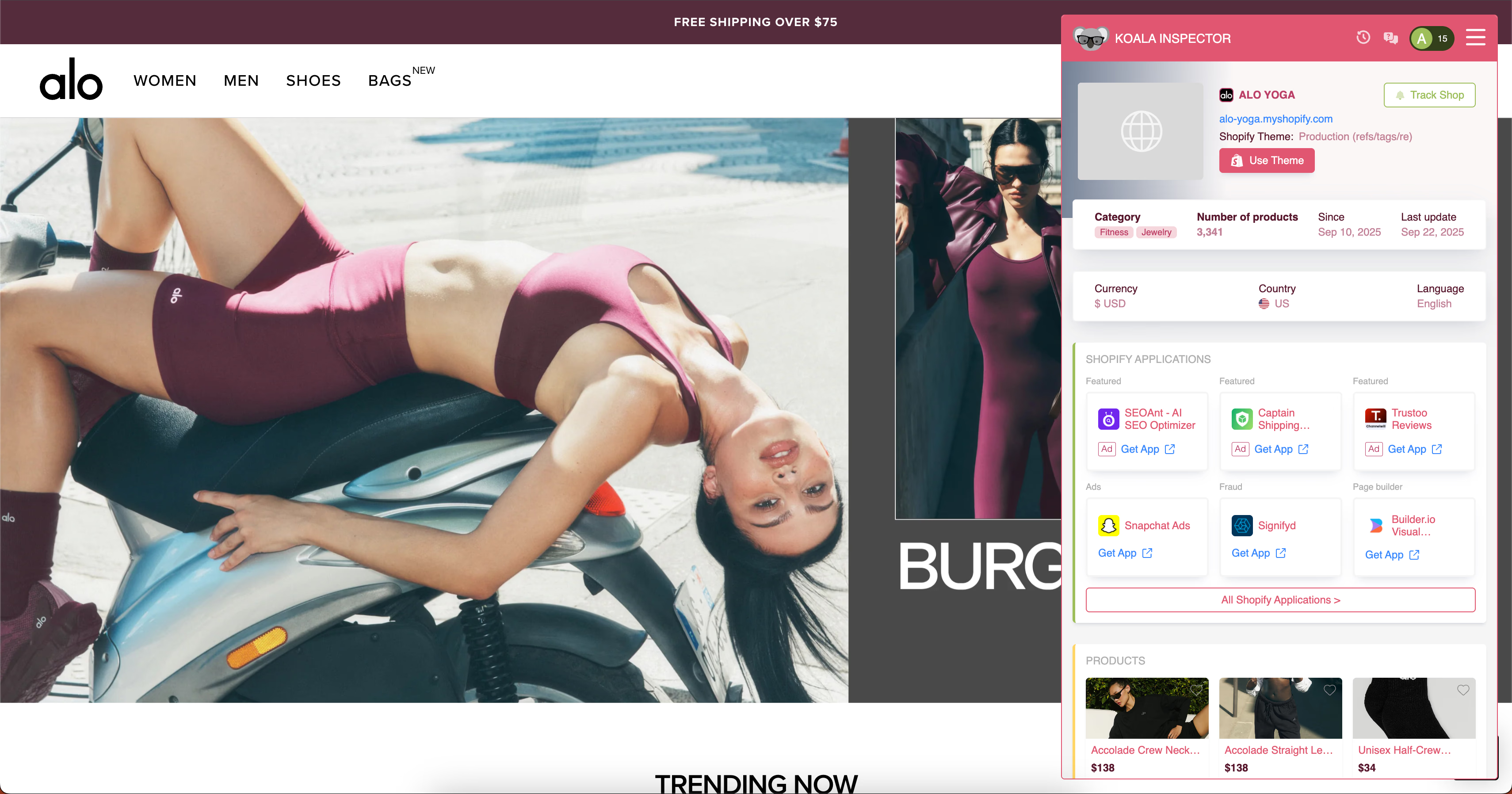
Koala Inspector tracks stores you’ve analyzed and sends alerts for significant changes, such as a sudden product range expansion.
It delivers detailed revenue breakdowns by product category and average order values, offering accuracy within 8% of actual figures. A remarkable feat for a free tool.
5. Sell The Trend
Sell The Trend’s “NEXUS” product discovery engine tracks over 7 million products daily. Its machine learning connects related items, revealing profitable niches rather than just one-off hits.
The platform includes an integrated store builder. You can find trending products, import them, optimize listings, and manage fulfillment—all without switching between tools. This speed proves crucial during peak seasons.
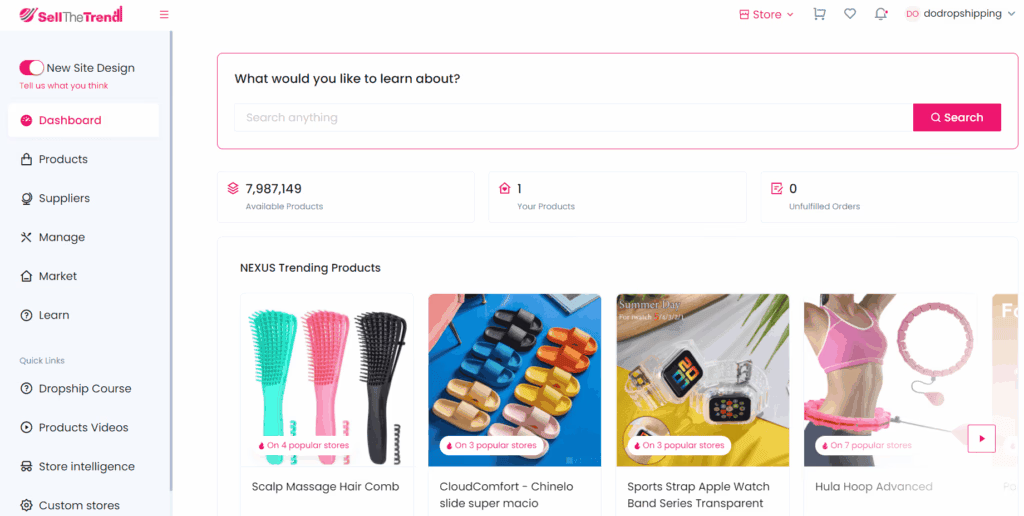
Users access over 45 hours of training from seven-figure sellers. These resources explain why trends matter, helping you build brands that convert, not just chase sales.
The analytics dashboard combines data from Facebook, Google, TikTok ads, and store metrics. You get a unified view to make smarter decisions without juggling multiple platforms.
The best ShopHunter alternative depends on your business needs and stage. To scale with heavy ad spending, Dropship.io provides a competitive advantage. For deep POD insights, PPSPY offers specialized tools.
Success comes from choosing the right tool that solves your specific challenges, not from using the fanciest software. Use these platforms to advance confidently, validate ideas, and avoid generic, ineffective research.
Specialized Alternatives for Specific Research Needs
Product research often requires precision tools tailored to unique challenges, rather than a one-size-fits-all solution. While ShopHunter covers basic needs, specialized platforms excel where it falls short.
1. AliExpress Dropshipping Center
This platform connects you directly with suppliers, letting you access important metrics like fulfillment speed and dispute rates. These details prove valuable during high-volume seasons.
During global shipping delays, merchants using the Dropshipping Center quickly switched to local suppliers. They avoided stockouts and customer issues. Users relying solely on competitor pages often faced supply disruptions.
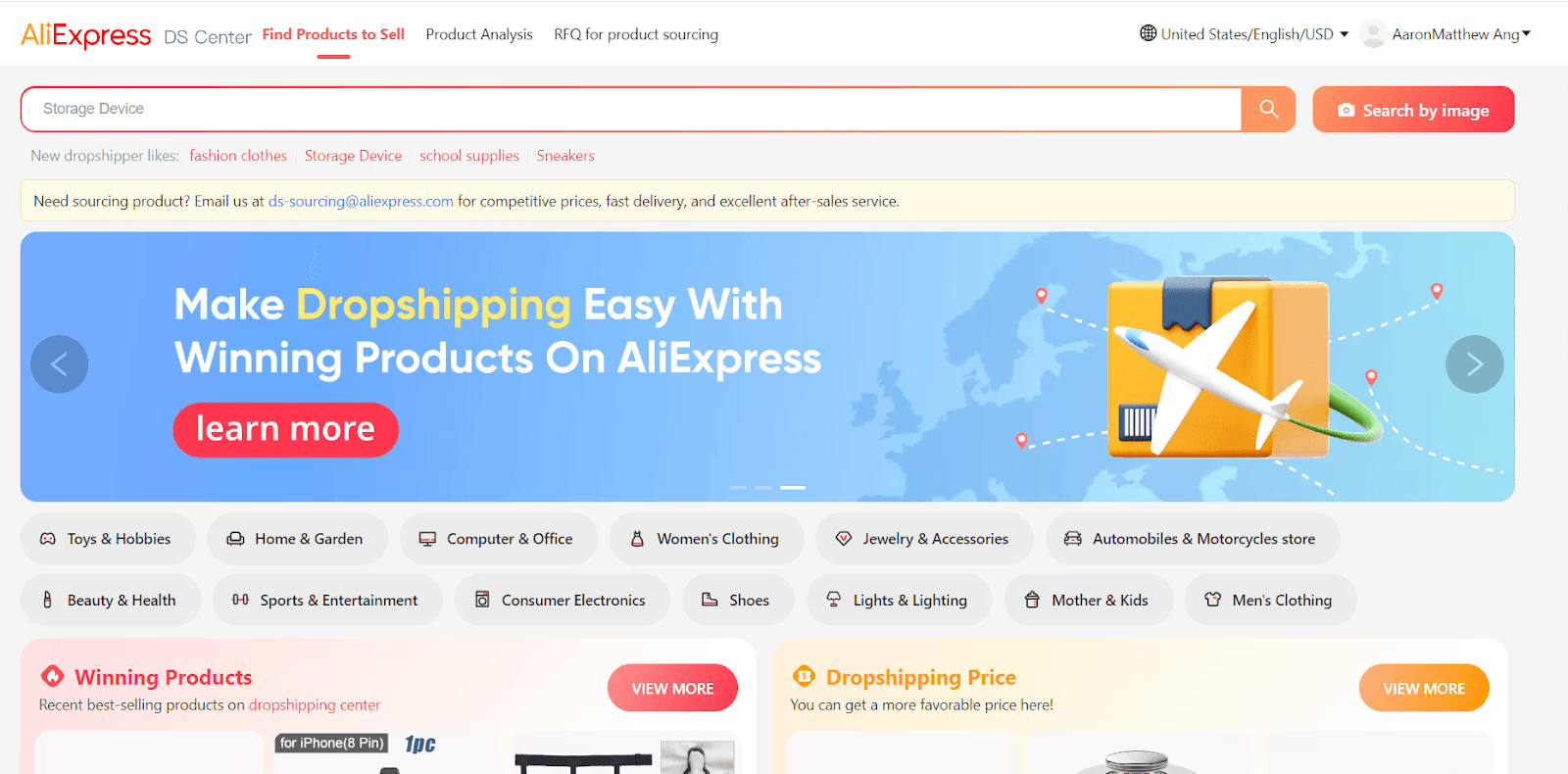
All features on the Dropshipping Center are free for AliExpress users. Some advanced options require minimum orders, but there’s no subscription fee, keeping startup costs low.
2. Ecomhunt
Ecomhunt excels at quickly identifying trends by scouting over 10 potential winning products daily. This speed keeps sellers ahead in trending niches.
Unlike ShopHunter, Ecomhunt provides complete marketing packages, including ad creatives, emotional hooks, and pricing strategies. This transparency eliminates guesswork about successful campaigns.
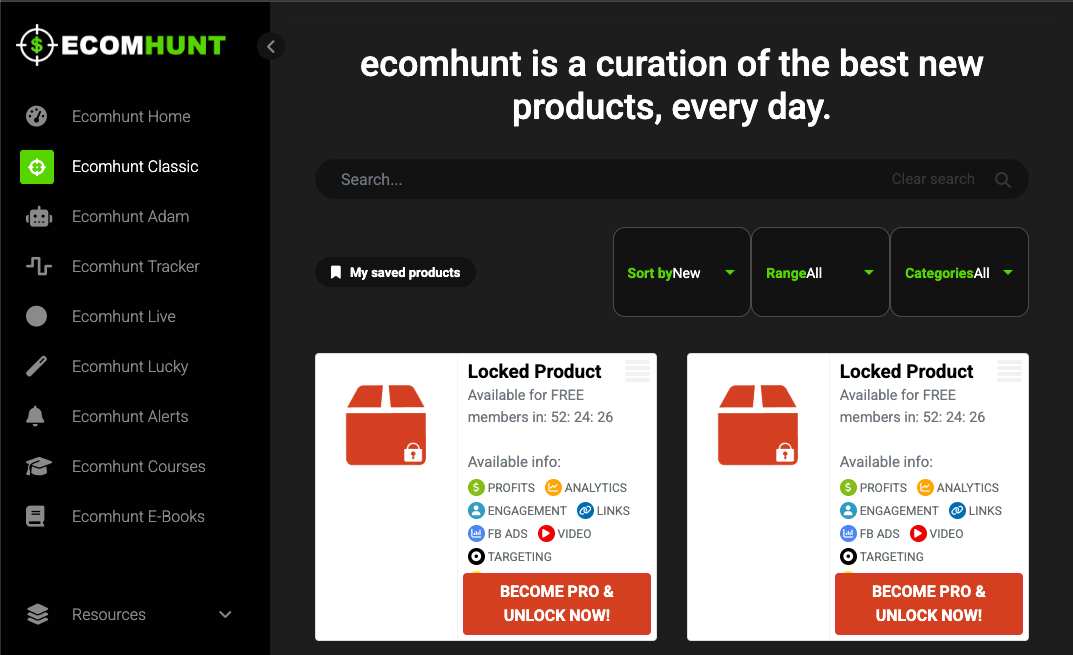
Its profit calculators incorporate real advertising costs. This reveals true profit margins and helps avoid losses that occur when marketing expenses get overlooked.
Plans start at $29 per month and include a free 7-day trial. The time saved in research and marketing setup easily compensates for the subscription fee.
3. Inventory Source
Inventory Source supports the entire supply chain, from onboarding suppliers to automating inventory updates and order processing. This reduces manual work common in dropshipping operations.
One seller used it to list products across Shopify, WooCommerce, and Amazon. Centralized management prevented overselling and simplified multi-channel sales.
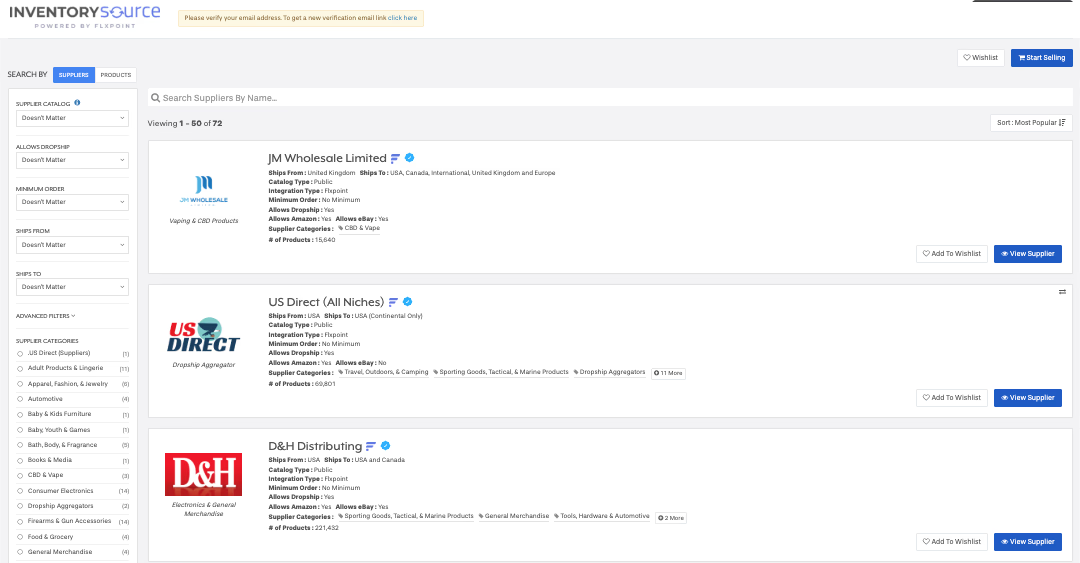
The platform offers access to a network of over 180 approved supplier. This connection ensures reliable sourcing at competitive prices.
Each of these specialized tools fills a specific gap left by ShopHunter. Whether it is supplier access, rapid trend identification, or fulfillment automation.
Depending on your current needs, combining these platforms can streamline every stage. From product research to delivery, reducing guesswork and wasted effort.
Want to dive deeper into choosing the right product research strategy? Our comprehensive guide covers the best product research tools for dropshipping and how to avoid common research mistakes that cost sellers thousands.
Feature Comparison and Pricing Breakdown
Many sellers struggle to find winning products. They jump from AliExpress to YouTube, hoping for inspiration. Meanwhile, competitors launch winners quickly and confidently.
Most comparison guides only show checkmarks. They don't explain what you really get. Here you see the critical differences clearly.
For example, ad tracking varies widely:
- ShopHunter: Shows which stores run ads but provides no creative examples, spend estimates, or performance data.
- Trendtrack: Gives the ad itself, estimated spend, impressions, and engagement—everything needed to judge if the ad converts.
A dropshipper who relied on ShopHunter might spend weeks chasing "hot" products with no profit. Popularity alone doesn't guarantee success. You also need acquisition cost and market saturation data. This is why your focus must be on tools like Trendtrack.
Discover What Sells Online
Uncover winning products and strategies before your competitors do. Trendtrack gives you access to 10,000+ trending Shopify stores and high-performing ads in one intuitive platform.

Pricing Comparison Overview
Free Tools
Tool | Features | Best For |
|---|---|---|
AliExpress Dropshipping Center | Supplier data, fulfillment metrics | Beginners, supplier research |
Koala Inspector | Store analysis, revenue estimates | Quick Shopify store analysis |
Paid Tools
Tool | Price Range | Best For |
|---|---|---|
Ecomhunt | $29 - $69 | Fast trend discovery with creatives |
Trendtrack | Starting at $47 | Advanced multi-platform intelligence |
Dropship.io | Starting at $39 | Professional traders, detailed analytics |
Sell The Trend | $40 - $50 | All-in-one dropshipping suite |
PPSPY | Contact for pricing | Print-on-demand specialists |
Inventory Source | Contact for pricing | Automation and fulfillment |
Here's how platforms truly differ in core capabilities:
Product Discovery
- ShopHunter: Basic bestseller and sales estimates
- Ecomhunt: Daily curated products with minimal data
- PPSPY: Good alerts but limited historical trends
- Trendtrack: Cross-platform trend detection, sales velocity, saturation, and profit estimates
Want to optimize your product research with profitability in mind? Explore the ROAS break-even calculator to better understand your margins.
Ad Intelligence
- ShopHunter: Basic ad presence indicators
- Ecomhunt: Complete ad creatives with marketing angles
- Trendtrack: Full ad performance metrics, spend analysis, and creative intelligence
- Others: Limited or no ad tracking capabilities
Your All-in-One E-commerce Intelligence Tool
Stop juggling multiple tools. Trendtrack provides comprehensive store analysis, trend tracking, and ad intelligence in a single dashboard.

Platform Coverage
- ShopHunter: Shopify-focused
- Trendtrack: Advanced Shopify analytics with cross-platform ad tracking
- PPSPY: Specialized for POD platforms (Etsy, Redbubble, etc.)
- Others: Platform-specific or limited coverage
Value-for-Money Assessment
Free Tier Winners:
- Koala Inspector: Unbeatable for quick Shopify analysis
- AliExpress Center: Essential for supplier validation
Premium Value Leaders:
- Ecomhunt ($29-$69): Multiple tiers for different needs
- Trendtrack (Starting at $59): Superior ROI for serious dropshippers
- Sell The Trend ($40-$50): Comprehensive suite justifies the cost
Specialized Solutions:
- PPSPY: Custom pricing for POD-focused businesses
- Inventory Source: Custom pricing that pays for itself through automation savings
It's about features that boost profits, not just long lists. Choose based on your specific needs and growth stage, not just the lowest price or longest feature list.
Make Your Product Research Count with the Right Alternative
Finding winning products doesn’t have to be a guessing game. The right ShopHunter alternative can shift your dropshipping business. It changes endless trial-and-error into a predictable, data-driven process.
You don’t have to rely only on instinct or scattered research. Use tools that provide real insights into what works in the market.




Are you ready to get the insights?
From viral trends to million-dollar stores — unlock the insights behind what sells, scales, and converts. All in one place.




.avif)

